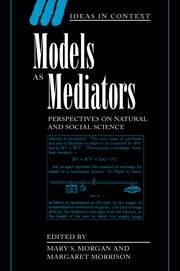Book contents
- Frontmatter
- Contents
- List of contributors
- Preface
- 1 Introduction
- 2 Models as mediating instruments
- 3 Models as autonomous agents
- 4 Built-in justification
- 5 The Ising model, computer simulation, and universal physics
- 6 Techniques of modelling and paper-tools in classical chemistry
- 7 The role of models in the application of scientific theories: epistemological implications
- 8 Knife-edge caricature modelling: the case of Marx's Reproduction Schema
- 9 Models and the limits of theory: quantum Hamiltonians and the BCS models of superconductivity
- 10 Past measurements and future prediction
- 11 Models and stories in hadron physics
- 12 Learning from models
- Index
10 - Past measurements and future prediction
Published online by Cambridge University Press: 10 March 2010
- Frontmatter
- Contents
- List of contributors
- Preface
- 1 Introduction
- 2 Models as mediating instruments
- 3 Models as autonomous agents
- 4 Built-in justification
- 5 The Ising model, computer simulation, and universal physics
- 6 Techniques of modelling and paper-tools in classical chemistry
- 7 The role of models in the application of scientific theories: epistemological implications
- 8 Knife-edge caricature modelling: the case of Marx's Reproduction Schema
- 9 Models and the limits of theory: quantum Hamiltonians and the BCS models of superconductivity
- 10 Past measurements and future prediction
- 11 Models and stories in hadron physics
- 12 Learning from models
- Index
Summary
INTRODUCTION
This paper studies the emergence of the first macroeconometric model and the national accounts from a social studies of science perspective. In the twentieth century, mathematics have increasingly been used to describe (parts of) the economy. Mathematisation of the social sciences (following the footsteps of physics) may look like an autonomous, universal and deterministic development. However, it has been the role of the social studies of science to show that these developments may seem autonomous if you look at what has become real and what our current society defines as necessary, but if you look in more detail to the process of establishing it, a much less deterministic, less autonomous, less universal and unavoidable picture arises.
The first macroeconometric model was developed by Jan Tinbergen in the 1930s and set the pattern for such models in economic science in the Western block. His type of modelling became the dominant methodology of the Dutch Central Planning Bureau (CPB) from the early 1950s. Macroeconometric modelling became part of university economics programmes as a consequence of which bureaucrats, Members of Parliaments and ministers increasingly conceived of the economy in those modelling terms. Jan Tinbergen's model has thus had an enormous influence on the international economics discipline as well as on Dutch policy making.
The fact that Dutch economists have all been taught the CPB's macroeconometric models as ‘standard knowledge’ has resulted in a view that the ‘model’ constitutes an objective piece of knowledge and consequently Dutch economic policy proposals are routinely ‘tested out’ on the model.
- Type
- Chapter
- Information
- Models as MediatorsPerspectives on Natural and Social Science, pp. 282 - 325Publisher: Cambridge University PressPrint publication year: 1999
- 21
- Cited by

